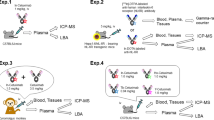Abstract
This study was conducted to investigate alterations that occur in an indium/111 Fab′ of a monoclonal antibody following its in vivo administration. Patients were infused with 111 In-Fab′ of the monoclonal antibody ZCE-025. Serum and urine specimens were collected from these patients. Starting materials, serum, urine and controls samples were studied by electrophoresis. Animal distribution studies were performed in normal Balb/c mice and, in some cases, nude mice bearing a carcinoembryonic antigen (CEA)/producing human colon tumour since the antibody targets CEA. The studies indicated that the molecule circulated almost totally intact for at least 4 h and to a considerable extent for 24 h, with some evidence for in vivo fragmentation by 24 h. Evidence was also obtained suggesting the formation of a high molecular weight species in some patients. Shortly after infusion, some of the 111In in the urine appeared as the intact Fab′, but within hours the majority migrated electro-phoretically as low molecular weight species. We conclude that while the majority of the 111In-Fab′ of this particular antibody remains intact and immunoreactive following its administration, the molecule is structurally changed to some degree shortly after its infusion into humans. Since each monoclonal antibody is unique, the degree and rapidity of degradation of its Fab′ in vivo could vary markedly from the above and possibly adversely effect its utility as a radiopharmaceutical.
Similar content being viewed by others
References
Beaumier PL, Krohn KA, Carrasquillo JA, et al (1985) Melanoma localization in nude mice with monoclonal Fab against P-97. J Nucl Med 26:1171–1179
Bouma JMW (1982) Some aspects of plasma protein metabolism as compared with intracellular protein breakdown. Acta Biol Med Germ 41:53–60
Bucheggar F, Haskell CM, Schreyer M, et al (1983) Radiolabeled fragments of monoclonal antibodies against carcinoembryonic antigen for localization of human colon carcinoma grafted into nude mice. J Exp Med 158:413–427
Buraggi GL, Callegaro L, Turrin A, et al (1984) Immunoscintigraphy with 123-I, 99mTc and 111-In labeled F(ab′)2 fragments of monoclonal antibodies to a human high molecular weight-melanoma associated antigen. J Nucl Med Allied Sci 28:283–295
Delaloye B, Bischof-Delaloye A, Bucheggar F, et al (1986) Detection of colorectal carcinoma by emission computerized tomography and after injection of 123I-labeled Fab or F(ab′)2 fragments from monoclonal anti-carcinoembryonic antigen antibodies. J Clin Invest 77:301–311
Halpern SE, Hagan PL, Fagnani RL, et al (1988a) Radioimmunopharmaceuticals (R): intact versus fragments in a tumor model. J Nucl Med 29:893
Halpern SE, Haindl W, Beauregard J, et al (1988b) Scintigraphy with In-111-labeled monoclonal anti-tumor antibodies: kinetics, biodistribution, and tumor detection. Radiology 168:529–536
Hamilton RG, Roebber M, Reimer CB, et al (1987) Isoelectric focusing-affinity immunoblocked analysis of mouse monoclonal antibodies to the four human IgG subclasses. Electrophoresis 8:127–134
Krejcarek GM, Tucker KL (1977) Covalent attachment of cheating groups to macromolecules. Bio Chem Bio Phys Res Commun 77:581–585
Larson SM, Carrasquillo JA, Krohn KA, et al (1983) Localization of 131-I-labeled P-97-specific Fab fragments in human melanoma as a basis for radiotherapy. J Clin Invest 72:2101–2114
Maack T, Johnson V, Kau ST, et al (1979) Renal filtration, transport and metabolism of low molecular weight proteins: a review. Kidney Int 16:251–270
Martin KW, Halpern SE (1984) Carcinoembryonic antigen production, secretion and kinetics in BALB/c mice in a nude mouse-human tumor model. Can Res 44:5475–5481
Reynolds JC (1988) Human anti-mouse antibody response in patients. In: Srivavastava SC (ed) Radiolabeled monoclonal antibodies for imaging and therapy. Plenum Press, New York, p 731
Tarburton JP, Halpern SE, Hagan PL, et al (1990) Effect of acetylation on monoclonal antibody ZCE-025 Fab′; distribution in normal and tumor bearing mice. J Biol Resp Mod 9:221–230
Author information
Authors and Affiliations
Additional information
Offprint requests to: S.E. Halpern Funded by the Veterans Administration
Rights and permissions
About this article
Cite this article
Halpern, S.E., Tarburton, J.P., Sudora, E. et al. Alterations in an indium-111 Fab′ under conditions of utilization. Eur J Nucl Med 19, 387–393 (1992). https://doi.org/10.1007/BF00177364
Received:
Issue Date:
DOI: https://doi.org/10.1007/BF00177364




